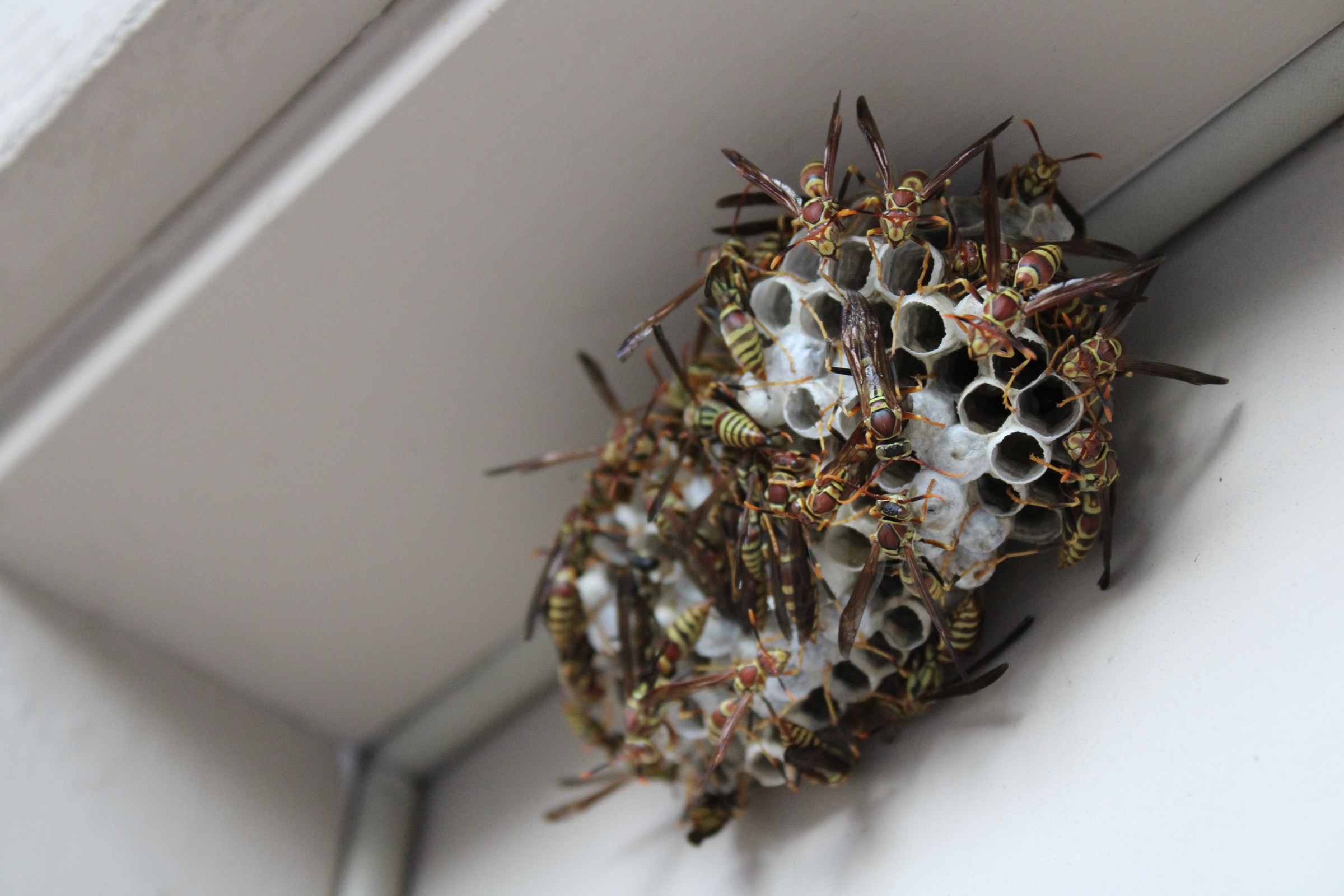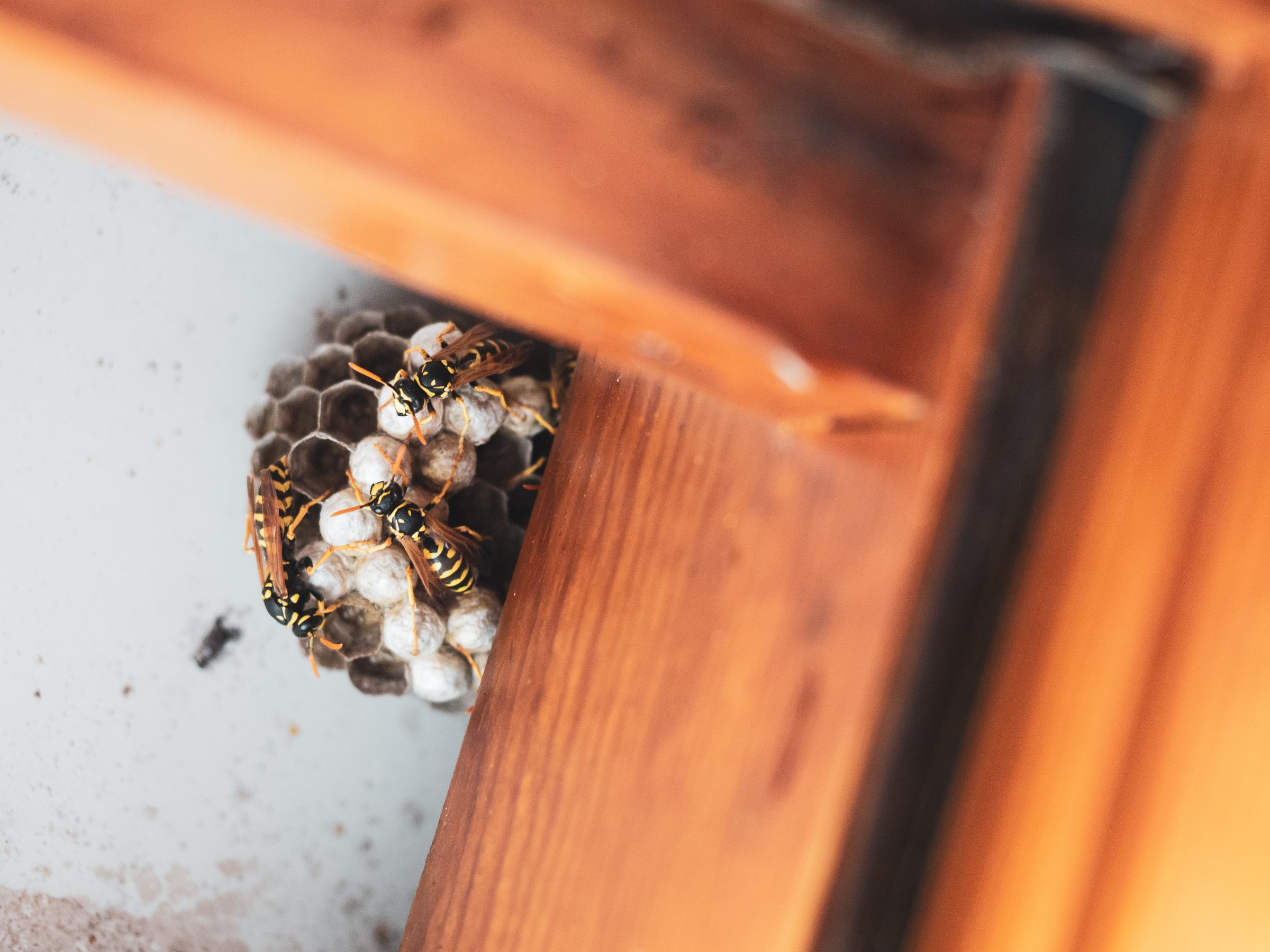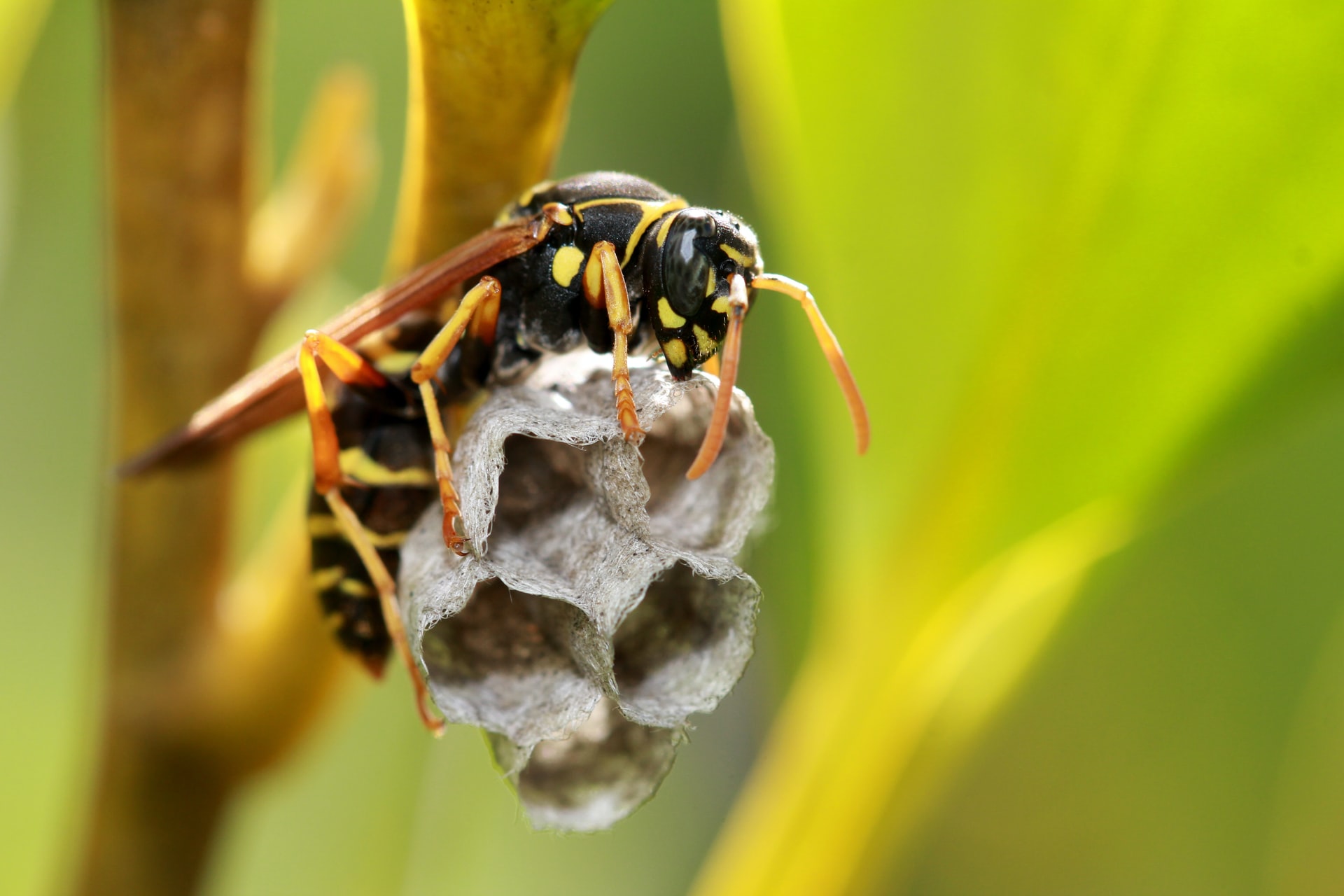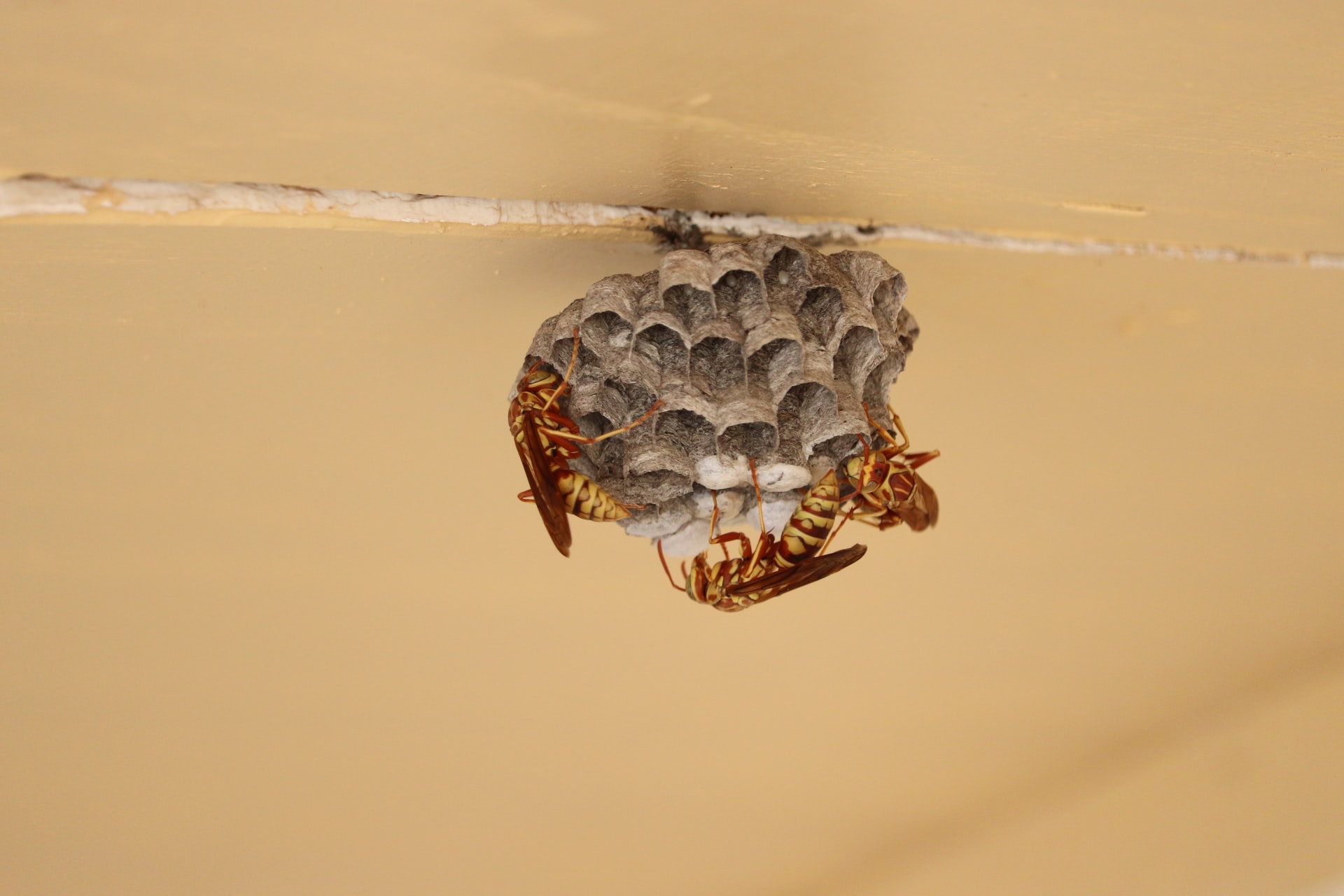In the attic, garage, garden and porch, you've likely seen paper wasps and their characteristic nests hanging around the home and garden. These misunderstood relatives of bees and ants have an important role in both urban and rural ecosystems. Paper wasps pollinate fruits and vegetables, and they even eat garden pests like nuisance caterpillars. Even though these ancient insects are largely beneficial, sometimes they make their umbrella-shaped nest in an inconvenient spot. Paper wasps don't go out of their way to sting, but they will become aggressive if they feel their nest is threatened. We'll take a look at some Earth-friendly ways of sending paper wasps on their way.

Identification
From afar, paper wasps look like long, skinny bees with large legs that dangle beneath them in flight. The most common paper wasps are about ¾ inch long, with some over 1 inch in length. Size, markings and color vary depending on the age and species. Most of the 24 species of the genus Polistes in the US are yellow or light brown with some red markings. The most common paper wasps in America are the northern paper wasp (Polistes fuscatus) and the European paper wasp (Polistes dominula). The European paper wasp is invasive, meaning that it was introduced to North America by humans. Recent research shows that these invasive wasps actually harm the survival of our native wasps, such as the northern paper wasp. Each species has a unique pattern of markings and nesting habits. For general paper wasps, the ID giveaway is their nests. They are considered social wasps, so they live together in a unique abode. The nests look like upside down brown paper combs, attached to a surface with a single stalk. They're also known as 'umbrella wasps' due to the umbrella-shaped structure of these upside-down nests.

DIY Wasp removal recommendations
For non aggressive wasps I've had great luck spraying the nests with this Spectracide wasp remover in the evening. For more aggressive wasps I also use this rediculous looking upper torso Beekeeping suit. It seems silly, but trust me, it's amazing.
Paper Wasp Natural History
Despite mixed opinions among humans, wasps have been a part of ecosystems on Earth for millenia. The oldest known fossils of wasps are 240 million years old! Paper wasps belong to a group of insects called hymenoptera, the third most diverse animal group in the world with over 150,000 species of wasps, bees and ants described so far. Scientifically, paper wasps belong to the genus Polistes, of which there are over 300 species.
They are defined by their unique paper nests located in shrubs, on tree branches, on porch ceilings, window frames, roof overhangs and just about any other spot they see fit. These 'paper nests' are made of a mixture of plant material and insect saliva that the queen constructs. She creates hexagon-shaped compartments to house her eggs. In the larval stage, worker wasps feed them caterpillar guts and other insect prey. These eggs will become pupa after one and a half months and once hatched, the young wasps will join her kingdom as workers.
Adult wasps feed on nectar from flowers, lending a helpful hand to pollination in agriculture and the home garden alike. However, invasive non-native European paper wasps have been observed killing monarch butterfly caterpillars on milkweed plants in the US. Nests typically have anywhere from 10 to 100 wasps. Some residents are non-reproductive wasps among the group whose entire existence is for serving the colony by finding food and caring for young.
As cold weather arrives in the fall, most wasps perish. But the mighty queen lives on by nesting in protected areas. By burrowing underground or sheltering under tree bark, the youngest queens wait out the winter and then emerge to start a new nest of their own. Nests are only used for one season.
Female wasps are larger than males. They carry the eggs and the best defenses. Female paper wasps have a modified ovipositor, commonly known as the stinger. Unlike the familiar honey bee, the stinger does not fall off after it's used. When a queen paper wasp is building her nest, she will need some wood to make her nest. Wasps 'girdle' trees, houses, outdoor furniture and anything else they can find to make the perfect cellulose glue to build a paper nest. This can be a problem if wasps scrape wood off anything of aesthetically value.
From garages and porches to farm fields and forests, these creatures are habitat generalists in North America. At least 24 of the 220 species of paper wasps have been observed in the United States. These members of the Vespid insect family are surprisingly beneficial in nature. Most are either predators of pesky small insects or pollinators of flowers. Unfortunately, they can damage fruits as they relish the sugars of the crop. They make up for it by eating herbivorous caterpillars that can do even more permanent damage to a crop.
The Sting and Other Troubles
Only female wasps can sting. Early in the evolution of vespids like bees and wasps, females needed a way to lay eggs into plants so that larvae could grow and feed. This is where the ovipositor (meaning 'egg-layer') entered the scene. Over time, this sharp ovipositor became useful as a weapon of defense. The ovipositor has evolved to become a specialized structure for injecting things, whether eggs or venom.
Most stings are the result of a human bumping into a nest. Paper wasps are not aggressive by nature, but when they feel their nest is threatened, they might swarm and sting the aggressor. Wasps don't lose their stinger after it is used, so the attack can continue until you are no longer perceived as a threat.
For most people, a sting brings sharp, temporary pain, redness and minor swelling. About 0.8% of children and 3% of adults are allergic to some insect stings. If allergic, a wasp sting can cause difficulty breathing, severe swelling, dizziness, rapid heartbeat, nausea and hives. This would be a proper cause for a hospital visit. If someone in your household might have allergies to bee stings or other insects, consider strategies for a safe, non-toxic removal.

How to Remove Paper Wasps
Paper wasp nests can be removed safely and effectively without the use of toxic pesticides that can harm human and environmental health. Safety first! Wear long sleeves, gloves and eye protection when removing a wasp nest. Check out these Earth-friendly ways of sending the wasps on their way.
- Nighttime removal: Paper wasps sleep at night. Recent research shows that wasps show all the signs of what we consider 'sleep'. They are slow to react if removed in the dark.
- Use red light for night vision: Many invertebrates can't see the color red due to the biology of their eyes and visual sensitivities (but they can see things we can't, like ultraviolet rays!) To avoid detection as you remove the nest, use a red flashlight or headlamp.
- Peppermint oil and other essential oil sprays can be used to deter wasps. It's pretty easy to make. Scientists have studied the effectiveness of this organic deterrent.
- Soapy water: This tried and true non-toxic tactic has been shown to get rid of wasps effectively. Learn more here.
- Additional tips: Don't break the nest open during removal. Doing so might cause the wasps to scatter in all directions around you.
- One option is to wait for the end of the nesting season in the fall. Cold weather brings an end to the use of a nest, and it won't be used again. This is only a valid option in areas with frequent freezing nights in the winter.
Keeping Them Away
Decoy wasp nests are a popular DIY creation, but science hasn't shown this to be effective. In fact, entomologists say that they most likely aren't of any use since paper wasps are regularly observed nesting in close proximity to one another. On the other hand, scientists have found several essential oils to be excellent repellants for paper wasps and other insects. Make sure that screens, windows, siding and other exposed areas are in good condition to discourage wasps from nesting on your home. Keep trash and empty cans inaccessible to wasps. Consider consulting a professional if the nest removal is too dangerous or risky for you. Don't be afraid to ask pest control for Earth-friendly, non-toxic removal.
Cool Facts About Wasps
- Only female wasps can sting. They are much larger than males. Some people even handle male wasps with their hands!
- The stinger is actually an ovipositor used to lay eggs. Fossils indicate that this structure evolved before the time of T. rex to deposit eggs into plants.
- Some males have tiny spikes on their abdomens that allow them to prick an attacker.
- Wasp venom contains more than 30 compounds, including protein toxins and various enzymes.
- Wasps are important pollinators in gardens and farms. They also eat nuisance garden pests like caterpillars.
- Wasps can become invasive species if they are transported to a new area. The common European paper wasps in the US are non-native invasives.
- Queens spend the winter burrowing underground, behind tree bark, or in a similar sheltered area like a home or attic.
- Nests are only used for one season. If winter is coming, they'll likely be gone soon!
Helpful Links
https://www.clemson.edu/extension/beekeepers/fact-sheets-publications/paper-wasps.html
http://idl.entomology.cornell.edu/wp-content/uploads/Paper-Wasps-CCE.pdf
https://agrilifeextension.tamu.edu/library/insects/paper-wasps-yellowjackets-and-solitary-wasps/
https://askentomologists.com/2015/09/23/why-cant-male-bees-or-wasps-sting/
https://bugguide.net/node/view/572
https://onlinelibrary.wiley.com/doi/abs/10.1002/ps.3411
